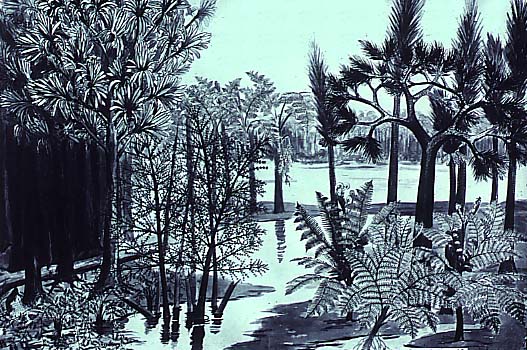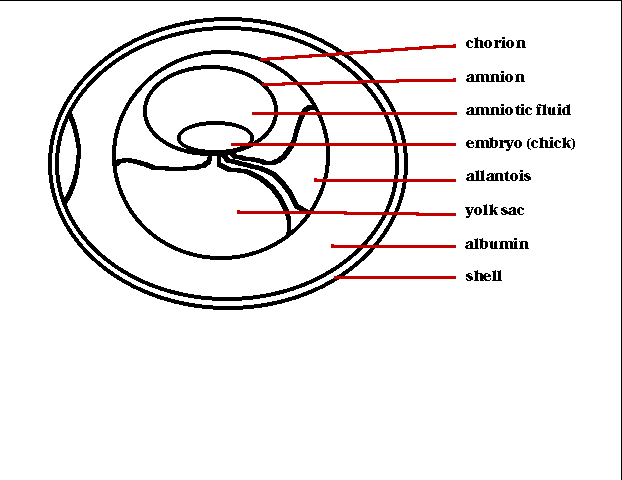The Carboniferous Period
Basic History
The Carboniferous Period extends from 360 million
years ago to 286 years ago, coming after the Devonian Period. The Carboniferous
(Coal Bearing) Period received its name from an Englishman, William Conybeare,
and was named for the large deposits of coal that have their origins during
this time period. The Carboniferous Period is broken up into two divisions,
the Pennsylvanian, which was the most coal bearing, and the Mississippian,
which was mostly limestone.
What ended the Carboniferous Period?
The formation of Pangea signaled the end of the Carboniferous Period.
Pangea caused a great upheaval on land and in the sea, and set up the basis
for new species of plants and animals.
Pennsylvanian Period (Upper Carboniferous) 325-286
mya
Major Adaptive Radiations
A new group of tetrapods, the diapsids, enters the scene. These are
the ancestors of reptiles, and actually the diapsids divides into two groups,
the 1) marine reptiles, snakes, and lizards and 2) the archosuars, which
includes crocodiles, dinosaurs and birds.
Amphibians also flourish. The major ancient amphibian groups appear.
Arthropods discover that spores are yummy.
Fauna
Shallow water covered most of the planet, except for Pangea. Attached
filter feeders, such as bryozoas
were in abundance. The ostracoderms, or armored fish, of the Devonian Period
become extinct and are replaced by more modern looking fish. Millipedes,
scorpions, and spiders also begin to play a larger role in the ecosystem.
Insects with wings that do not fold back, such as Dragonflies, radiate
and thrive.
Tetrapods become more diverse, with their body shapes becoming less
like fish and growing sprawling limbs and flattened heads. The first land
snails occur.
 Amphibiamus
Amphibiamus
Flora
Swamp forests with highly diverse vegetation become common. In the
swamps are lycopods, or seedless plants, that grew to 35 feet tall. Some
of the swamp plants had large tops and laterally spreading roots which
were ideally suited to the wide, flat, poorly drained land surfaces. These
plants grew densely in bogs and swamps along the flood plains, estuaries
and shorelines of lakes, and possibly in coastal areas. Ferns become very
important. Sphenophytes, the ancestor to Equisetum, appears and
flourished, producing trees up to 100 feet tall.
 Coal
Swamp, common in the Pennsylvanian.
Coal
Swamp, common in the Pennsylvanian.
Continental Drift
The Carboniferous was marked by the progressive formation of the supercontinent
Pangea. The present day Northern Hemisphere mandamuses moved towards the
equator to form Laurasia and to join the large Southern Hemisphere land
mass Gondwana. The collision between Siberia and Eastern Europe created
the Ural Mountains, and China was formed with the collision of several
microcontinents and Siberia. The collision between Gondwana and Laurasia
led to the formation of the Appalachian belt in North America and the Hercynian
Mountains in Europe. Gondwana also shifted towards the equator while the
continents moved from east to west.
Coal beds, which can be up to eleven to twelve meters thick, characterize
the Upper Carboniferous. The forests of seedless vascular plants that existed
in the tropical swamp forests of Europe and North America provided the
organic material that became coal. Dead plants did not completely decay
and were turned to peat in these swamp forests. When the sea covered these
swamps, marine sediments covered the peat. Eventually, heat and pressure
transformed these organic remains into coal.
Mississippian Period (Lower Carboniferous) 360-325
mya
Climate
The climate during the early Carboniferous Period was uniformly tropical.
There were no distinct seasons. This is due to the vast oceans that covered
everything except the massive land masses Laurassia and Gondwana.
Adaptive Radiation
Terrestrial radiation occurred because of drying trends that were the
result of large glaciers, most of which originated in the South Pole of
the time. As the glaciers passed over the land, they absorbed the majority
of the water in the shallow oceans, which resulted in the extinction of
shallow marine vertebrates such as bryozoans, the swamps dried up, and
terrestrial land increased.
Freshwater clams first appear along with an increase in bony
fish, and shark diversity.
The first conifers appear.
By far, the most important structure to come about during the Mississippian
Period was the amniotic egg. As the atmosphere became more arid, there
came a need for a reproductive structure that could stand the pressures.
The amniotic egg, seen in the picture below, has an outer shell that prevents
drying and membranes that nourish and protect the embryo.

Continental Drift
Near the end of the Mississippian, uplift and erosion of the continents
occurred, causing an increase in the number of flood plains and deltas
present. The Missisippian Period is known for its limestone deposits, which
is a result of the crinoids, lime-crusted green algae, and calcium carbonate
shaped by waves. During the late Early Carboniferous, East Gondwanaland,
for the first time since Early Paleozoic, began to drift toward the South
Pole. By early Late Carboniferous, the South American-North African
margin of Gondwanaland had collided with the northern Devonian supercontinent
of Euramerica becomes Laurasia by the late Carboniferous.
Fauna
corals, crinoids, and bryzoans
Freshwater clams first appear along with an increase in bony fish,
and shark diversity.
Flora
Mostly shrub bushes, about 2 meters tall
Lycopsids and calamite trees
Glossary
calamite- horsetails
crinoids- marine organisms with calcium shells
tetrapods- Organisms with four limbs
Sources Cited
http://www.kheper.auz.com/gaia/Paleozoic/Carboniferous/Mississippian.htm
http://www.ucmp.berkeley.edu/carboniferous
Chaloner, W.G. 1991. Fossil evidence for plant-arthropod interactions
in the Palaeozoic and Mesozoic. Phil. Trans. R.Soc.
Lond. 333:177-186
Daeschler, E.B., Neil Shubin 1995. Tetrapod Origins. Paleobiology 21:404-409.
 Amphibiamus
Amphibiamus
 Coal
Swamp, common in the Pennsylvanian.
Coal
Swamp, common in the Pennsylvanian.
